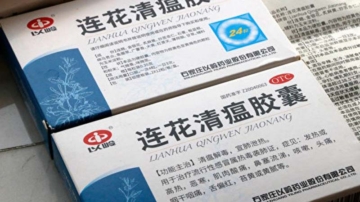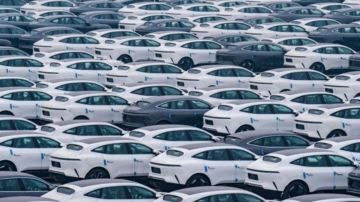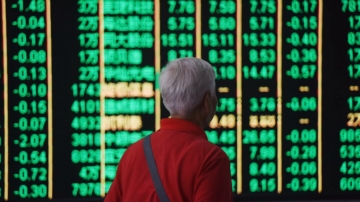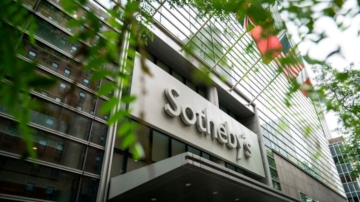【新唐人2014年02月01日讯】中共国家审计署日前公布全国政府性债务统计数据显示,截至2013年6月底,中共政府的总体债务达30万3千亿元人民币,占GDP 53.3%﹔其中地方政府性债务攀升到17万9千亿元人民币。那么中国地方政府债务风险到底有多大?地方政府性债务总体风险是否像中共所说在“可控”范围?所谓“国企私有化”真能解决地方政府债务吗?我们听听专家的分析。
去年12月30号,中共国家审计署发布2013年第32号公告,截至2013年6月底,全中国从中央到乡镇五级政府性债务总额中,中央和地方政府性债务总额30万2700亿元,负有偿还责任的债务约20万7千亿元,负有担保责任的债务2万9300亿元,可能承担一定救助责任的债务6万6500亿元。比两年多以前统计的债务数字猛增67%。
北京《国情内参》期刊首席研究员巩胜利:“2013年已经过去了,中国的国民生产总值,从31个省市提供的国民生产总值大概是61万亿人民币,减去刚才说的总债务和要到期的,要偿还的债务,这就知道了中国目前债务的一些问题。”
北京《国情内参》期刊首席研究员龚胜利表示,按照美国、欧盟等国家制定的规则,债务不能超过国民生产总值,而中国地方债务有的高得不可想像。
英国《路透社》1月27号报导说,全中国31个省和直辖市,有30个发布了地方债务审计声明,地方公共债务总额达3万亿美元。而中国最富裕的东部省份,是负债最多的。它的债务占GDP比例达到79%。
另据审计署的抽查,36个地方政府中,截至2012年末,有9个省会城市本级政府负有偿还责任的债务率超过100%,最高达189%,如果加上政府负有担保责任的债务,债务率最高者达219.6%。
巩胜利说,中国的南京、武汉、广州3个城市目前债务最严峻,债务的总量都超过了国民生产GDP的总和。
巩胜利:“南京方面比较严峻,大概接近200%,武汉大概超过150%,广州大概超过了100%多一些。简单的说,它这个城市花出去的钱,比它产出的GDP要高出很多,广州大概超出了一半以上,这个情况从目前来看有加剧的可能.”
巩胜利表示,产生这个结果,是由于中国还债和债务的生成连接、生长环境不畅通,国家也没有政府的破产机制,出现状况就是政府从中央银行直接拨钱解决。
中共官方日前表示,中国政府的总体债务,约占GDP53.3 %,仍然处于国际公认的60%的警戒线以下。地方政府性债务总体风险“可控”。
大陆金融分析师任中道表示,中共的GDP等各方面的数据,连总理李克强都说是不可靠的,因此不能用真正的市场经济,来衡量中共政府。
任中道:“中国政府大家都知道它是一个流氓政权,那么它的偿债能力和还债意愿都需要得到质疑。有些国际机构的一些学家或者是研究人员,也是用这个比例、不超过GDP比例的60%的比例来说话,但是,因为中共本质导致了不能这么衡量。”
巩胜利:“现在中国审计署说可以解决这些问题,但是,有一点中国政府的投资也好,花钱也好,由政府自己说了算。中国还有一个机制就是,政府是在党的管理之下,只要党组织同意了,那么地方政府就可以当然的举债。长期这种治理债务,那真的是很风险。”
1月24号,世界经济论坛2014年“达沃斯年会”上,中共发改委副主任张晓强谈到地方债问题时表示,中央政府债务占GDP20%,地方政府占40%,加起来60%。而在大力发展混合制经济的情况下,政府可通过“地方国企私有化”这个方式,获取还债资金。
任中道表示,这是给中共权贵开路,在转嫁债务的同时,慢慢控制国有企业,使国有资产变成权贵的东西。
而巩胜利则表示,如果不根本上改变中共体制,这些债务会像滚雪球一样越滚越大。
采访编辑/易如 后制/李勇
Is China's Local Government Debt Risk Under Control?
China's National Auditing Office (NAO) data shows that its total government debt reached 30.3 trillion yuan (US$5 trillion) as of June 2013.
It accounts for 53.3% of GDP.
The local government debt swelled to 17.9 trillion yuan
($2.95 trillion) out of the total.
How much of a risk is local government debt?
Will this be like what the government has claimed, "it is under control"?
Will the "state-owned enterprises privatization" solve the local debt problem?
Let's take a look at what the experts say.
On 30th December, 2013, NAO issued notice 2013 No.32.
As of the of June 2013, above five-tier township-level regimes combined debt had reached 30.2 trillion yuan (US$ 5 trillion).
The liabilities debt is about 20.7 trillion yuan (US$ 3.4 trillion), the credit guaranteed debt is about 2.93 trillion yuan (US$ 480 billion), the government might repay 6.65 trillion yuan (US$ 1.1 trillion). The total debt is 67% higher than the debt occurred in 2010.
Gong Shengli, lead researcher of a financial magazine:2013 has passed.
China's Gross National Product (GNP) was provided by 31 local regions totaling
about 61 trillion yuan ($US 10 trillion).
If we deduct the current total debt including debt expired soon, as well as the debt needed to be repaid,we can tell the real problem of the current debt.
Gong Shengli says that according to the US and EU's rule,the debt should not exceed GNP, however,the debt in some local governments in China is tremendously high.
On Jan. 27, UK Reuters reported that audit statements from 30 of China's 31 local regions showed that their total debt had reached $3 trillion.
The wealthiest eastern provinces are the most indebted, with
the ratio of debt to GDP being 79%.
NAO's survey taken from 36 regions shows, as of the end of 2012, nine capital cities'local government bears the responsibility to repay the debt rate over 100%, up to 189% plus the guaranteed debt, where the debt ratio reached its highest of 219.6%.
Gong Shengli says that Nanjing, Wuhan and Guangdong are the worst, their total debt exceeded the GDP's total.
Gong Shengli: Nanjiang is the most serious, which has exceeded 200%, Wuhan has exceeded 150%, Guangzhou has exceeded 100%.
To put in a simple way, they have spent far more than its GDP.From the current situation, it likely to get worse.
Gong says that the cause of this result is that the repayment of the debt and borrowing link within the system are unsmooth, there is no government bankruptcy system,when the problem occurs, the government will take money from the central bank.
The Chinese regime officially says that the total government debt accounts for 53.3%, it is in the secure range of the international margin of 60%.
So it claims the local government debt is "under control".
Ren Zhongdao, financial analyst in Mainland China says that according to China's GDP data in various areas,even premier Li Keqiang's words are not reliable.
Ren claims the Chinese Communist regime cannot make use of the real marketing economy.
Ren Zhongdao: People know that the Chinese regime is a rogue regime.Its repayment ability and the will of repayment need to be questioned.Some of the international experts also use this ratio of 60% as a judgment on China, however, the evil nature of Communist China tells us it doesn't work.
Gong Shengli: Now NAO says the problem can be resolved.One point is that the government's investment and spending are decided by the government itself.
China has another system being that the government is under the Communist Party's control, as long as the party agrees, the local government can borrow.
The long-term of using such a way to manage the debt is a real risk.
On Jan. 24, in the meeting of the World Economic Forum in Davos, Chinese officials regarding local government said that central government debt accounts for 20% of GDP, local accounts for 40%, the total is of 60%.Under the vigorously developing economic situation, the government can obtain funds via state-owned local enterprises privatization.
Ren Zhongdao says that this is to pave a way for communist elite groups, while diverting the debt, they gradually control the state-own enterprises, so the state-owned assets will fall into the elites'pockets.
Gong Shengli says that without changing the root of the communist system, all this debt can become a snowball, getting bigger and bigger.
Interview & Edit/YiRu Post-Production/LiYong
去年12月30号,中共国家审计署发布2013年第32号公告,截至2013年6月底,全中国从中央到乡镇五级政府性债务总额中,中央和地方政府性债务总额30万2700亿元,负有偿还责任的债务约20万7千亿元,负有担保责任的债务2万9300亿元,可能承担一定救助责任的债务6万6500亿元。比两年多以前统计的债务数字猛增67%。
北京《国情内参》期刊首席研究员巩胜利:“2013年已经过去了,中国的国民生产总值,从31个省市提供的国民生产总值大概是61万亿人民币,减去刚才说的总债务和要到期的,要偿还的债务,这就知道了中国目前债务的一些问题。”
北京《国情内参》期刊首席研究员龚胜利表示,按照美国、欧盟等国家制定的规则,债务不能超过国民生产总值,而中国地方债务有的高得不可想像。
英国《路透社》1月27号报导说,全中国31个省和直辖市,有30个发布了地方债务审计声明,地方公共债务总额达3万亿美元。而中国最富裕的东部省份,是负债最多的。它的债务占GDP比例达到79%。
另据审计署的抽查,36个地方政府中,截至2012年末,有9个省会城市本级政府负有偿还责任的债务率超过100%,最高达189%,如果加上政府负有担保责任的债务,债务率最高者达219.6%。
巩胜利说,中国的南京、武汉、广州3个城市目前债务最严峻,债务的总量都超过了国民生产GDP的总和。
巩胜利:“南京方面比较严峻,大概接近200%,武汉大概超过150%,广州大概超过了100%多一些。简单的说,它这个城市花出去的钱,比它产出的GDP要高出很多,广州大概超出了一半以上,这个情况从目前来看有加剧的可能.”
巩胜利表示,产生这个结果,是由于中国还债和债务的生成连接、生长环境不畅通,国家也没有政府的破产机制,出现状况就是政府从中央银行直接拨钱解决。
中共官方日前表示,中国政府的总体债务,约占GDP53.3 %,仍然处于国际公认的60%的警戒线以下。地方政府性债务总体风险“可控”。
大陆金融分析师任中道表示,中共的GDP等各方面的数据,连总理李克强都说是不可靠的,因此不能用真正的市场经济,来衡量中共政府。
任中道:“中国政府大家都知道它是一个流氓政权,那么它的偿债能力和还债意愿都需要得到质疑。有些国际机构的一些学家或者是研究人员,也是用这个比例、不超过GDP比例的60%的比例来说话,但是,因为中共本质导致了不能这么衡量。”
巩胜利:“现在中国审计署说可以解决这些问题,但是,有一点中国政府的投资也好,花钱也好,由政府自己说了算。中国还有一个机制就是,政府是在党的管理之下,只要党组织同意了,那么地方政府就可以当然的举债。长期这种治理债务,那真的是很风险。”
1月24号,世界经济论坛2014年“达沃斯年会”上,中共发改委副主任张晓强谈到地方债问题时表示,中央政府债务占GDP20%,地方政府占40%,加起来60%。而在大力发展混合制经济的情况下,政府可通过“地方国企私有化”这个方式,获取还债资金。
任中道表示,这是给中共权贵开路,在转嫁债务的同时,慢慢控制国有企业,使国有资产变成权贵的东西。
而巩胜利则表示,如果不根本上改变中共体制,这些债务会像滚雪球一样越滚越大。
采访编辑/易如 后制/李勇
Is China's Local Government Debt Risk Under Control?
China's National Auditing Office (NAO) data shows that its total government debt reached 30.3 trillion yuan (US$5 trillion) as of June 2013.
It accounts for 53.3% of GDP.
The local government debt swelled to 17.9 trillion yuan
($2.95 trillion) out of the total.
How much of a risk is local government debt?
Will this be like what the government has claimed, "it is under control"?
Will the "state-owned enterprises privatization" solve the local debt problem?
Let's take a look at what the experts say.
On 30th December, 2013, NAO issued notice 2013 No.32.
As of the of June 2013, above five-tier township-level regimes combined debt had reached 30.2 trillion yuan (US$ 5 trillion).
The liabilities debt is about 20.7 trillion yuan (US$ 3.4 trillion), the credit guaranteed debt is about 2.93 trillion yuan (US$ 480 billion), the government might repay 6.65 trillion yuan (US$ 1.1 trillion). The total debt is 67% higher than the debt occurred in 2010.
Gong Shengli, lead researcher of a financial magazine:2013 has passed.
China's Gross National Product (GNP) was provided by 31 local regions totaling
about 61 trillion yuan ($US 10 trillion).
If we deduct the current total debt including debt expired soon, as well as the debt needed to be repaid,we can tell the real problem of the current debt.
Gong Shengli says that according to the US and EU's rule,the debt should not exceed GNP, however,the debt in some local governments in China is tremendously high.
On Jan. 27, UK Reuters reported that audit statements from 30 of China's 31 local regions showed that their total debt had reached $3 trillion.
The wealthiest eastern provinces are the most indebted, with
the ratio of debt to GDP being 79%.
NAO's survey taken from 36 regions shows, as of the end of 2012, nine capital cities'local government bears the responsibility to repay the debt rate over 100%, up to 189% plus the guaranteed debt, where the debt ratio reached its highest of 219.6%.
Gong Shengli says that Nanjing, Wuhan and Guangdong are the worst, their total debt exceeded the GDP's total.
Gong Shengli: Nanjiang is the most serious, which has exceeded 200%, Wuhan has exceeded 150%, Guangzhou has exceeded 100%.
To put in a simple way, they have spent far more than its GDP.From the current situation, it likely to get worse.
Gong says that the cause of this result is that the repayment of the debt and borrowing link within the system are unsmooth, there is no government bankruptcy system,when the problem occurs, the government will take money from the central bank.
The Chinese regime officially says that the total government debt accounts for 53.3%, it is in the secure range of the international margin of 60%.
So it claims the local government debt is "under control".
Ren Zhongdao, financial analyst in Mainland China says that according to China's GDP data in various areas,even premier Li Keqiang's words are not reliable.
Ren claims the Chinese Communist regime cannot make use of the real marketing economy.
Ren Zhongdao: People know that the Chinese regime is a rogue regime.Its repayment ability and the will of repayment need to be questioned.Some of the international experts also use this ratio of 60% as a judgment on China, however, the evil nature of Communist China tells us it doesn't work.
Gong Shengli: Now NAO says the problem can be resolved.One point is that the government's investment and spending are decided by the government itself.
China has another system being that the government is under the Communist Party's control, as long as the party agrees, the local government can borrow.
The long-term of using such a way to manage the debt is a real risk.
On Jan. 24, in the meeting of the World Economic Forum in Davos, Chinese officials regarding local government said that central government debt accounts for 20% of GDP, local accounts for 40%, the total is of 60%.Under the vigorously developing economic situation, the government can obtain funds via state-owned local enterprises privatization.
Ren Zhongdao says that this is to pave a way for communist elite groups, while diverting the debt, they gradually control the state-own enterprises, so the state-owned assets will fall into the elites'pockets.
Gong Shengli says that without changing the root of the communist system, all this debt can become a snowball, getting bigger and bigger.
Interview & Edit/YiRu Post-Production/LiYong








